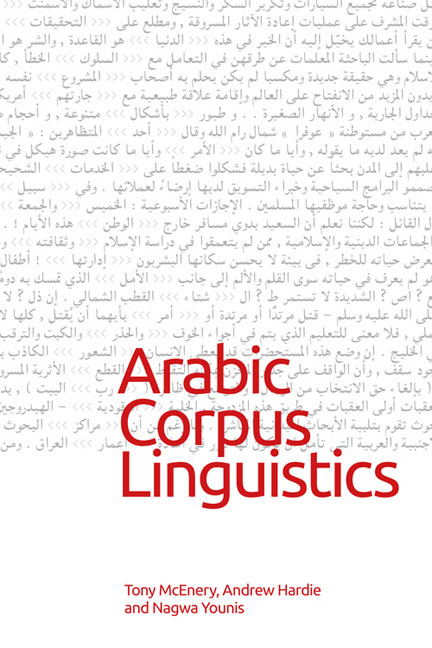Book contents
- Frontmatter
- Contents
- Notes on Contributors
- 1 Introducing Arabic Corpus Linguistics
- 2 Under the Hood of arabiCorpus
- 3 Tunisian Arabic Corpus: Creating a Written Corpus of an ‘Unwritten’ Language
- 4 Accessible Corpus Annotation for Arabic
- 5 The Leeds Arabic Discourse Treebank: Guidelines for Annotating Discourse Connectives and Relations
- 6 Using the Web to Model Modern and Qurʾanic Arabic
- 7 Semantic Prosody as a Tool for Translating Prepositions in the Holy Qurʾan: A Corpus-Based Analysis
- 8 A Relational Approach to Modern Literary Arabic Conditional Clauses
- 9 Quantitative Approaches to Analysing come Constructions in Modern Standard Arabic
- 10 Approaching Text Typology through Cluster Analysis in Arabic
- Appendix: Arabic Transliteration Systems Used in This Book
- Index
9 - Quantitative Approaches to Analysing come Constructions in Modern Standard Arabic
Published online by Cambridge University Press: 11 November 2020
- Frontmatter
- Contents
- Notes on Contributors
- 1 Introducing Arabic Corpus Linguistics
- 2 Under the Hood of arabiCorpus
- 3 Tunisian Arabic Corpus: Creating a Written Corpus of an ‘Unwritten’ Language
- 4 Accessible Corpus Annotation for Arabic
- 5 The Leeds Arabic Discourse Treebank: Guidelines for Annotating Discourse Connectives and Relations
- 6 Using the Web to Model Modern and Qurʾanic Arabic
- 7 Semantic Prosody as a Tool for Translating Prepositions in the Holy Qurʾan: A Corpus-Based Analysis
- 8 A Relational Approach to Modern Literary Arabic Conditional Clauses
- 9 Quantitative Approaches to Analysing come Constructions in Modern Standard Arabic
- 10 Approaching Text Typology through Cluster Analysis in Arabic
- Appendix: Arabic Transliteration Systems Used in This Book
- Index
Summary
Introduction
The fundamental tenet of constructionist theories of language is that the basic unit of linguistic organisation is a construction. According to Croft and Cruse (2004: 257), constructions ‘consist of pairings of form and meaning that are at least partially arbitrary’, where ‘meaning’ is basically defined as the conventionalised function of a construction. This conventionalisation of a construction's meaning/function not only includes the literal meaning of an expression, but also properties of the discourse situation in which an expression occurs (e.g. use of spatial deictic terms, such as here or there, that signal a reference point in a speech event) as well as the pragmatic implications of an expression (e.g. use of a yes/no question to request information, as in Do you have the time?) (Croft and Cruse 2004). The term ‘constructions’, therefore, covers both (1) the idiomatic portions of language – where the morphosyntactic structure of the expression may, in some cases, be idiosyncratic and where the meaning of an expression is not predictable from the component parts that make up the expression (e.g. raining cats and dogs) – as well as (2) any combination of two or more morphemes where only general morphosyntactic structures are utilised and where the meaning of an expression is fully predictable from its component parts (e.g. I want to go). This view of grammar postulates that ‘the interaction of syntax and lexicon is much wider and deeper than the associations of certain verbs with certain complements’ (Bybee 2010: 77), and that a considerable part of our linguistic knowledge consists of conventionalised expressions, or constructions (Langacker 1987).
According to any constructionist framework, therefore, the behaviour of a lexical item is best understood in its context of use and not in isolation. The syntactic structures in which it appears, the morphological inflections associated with it, its lexical collocates, and so on, all contribute to the (conventionalised) meaning or function expressed by this linguistic item. Such an approach calls for moving beyond single semantic, morphological, or syntactic properties of an individual lexical item to scrutinise the entire lexico-syntactic frame in which it appears.
- Type
- Chapter
- Information
- Arabic Corpus Linguistics , pp. 170 - 200Publisher: Edinburgh University PressPrint publication year: 2018



